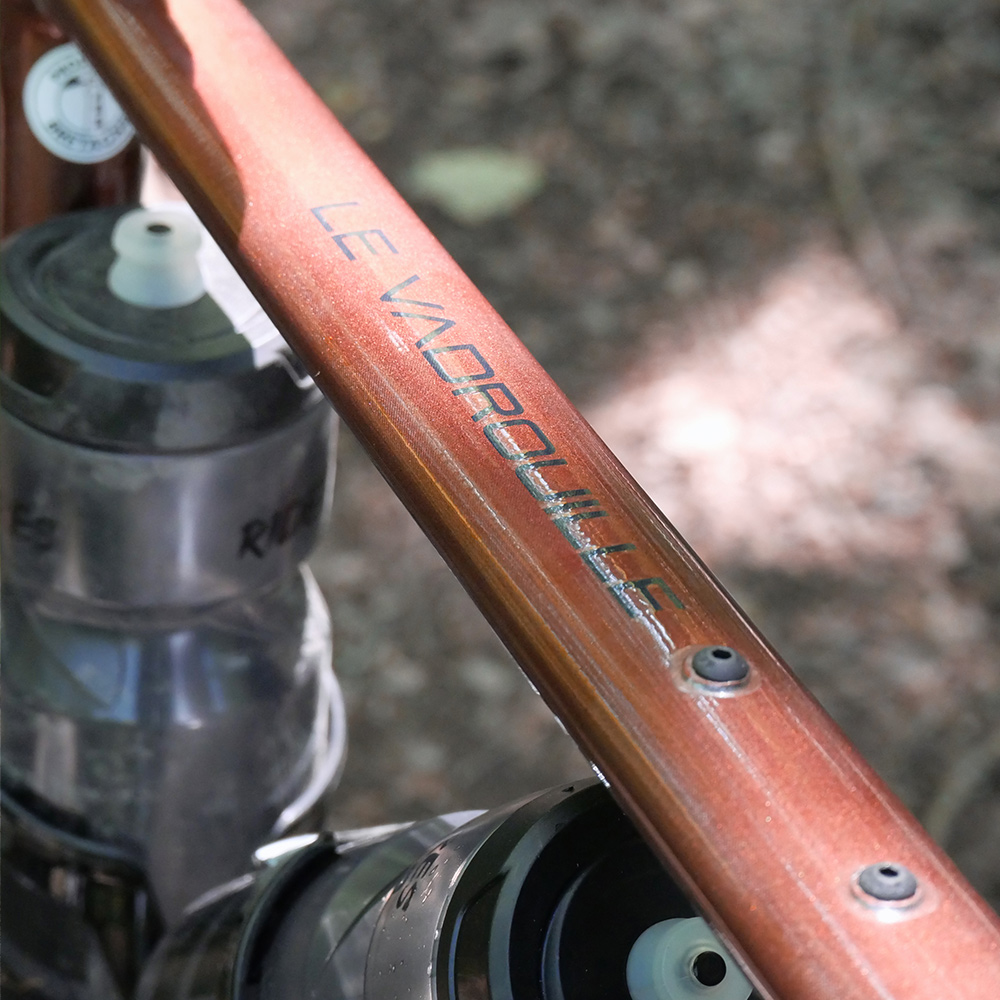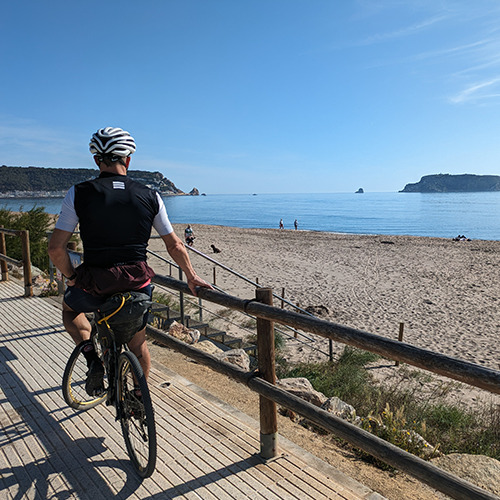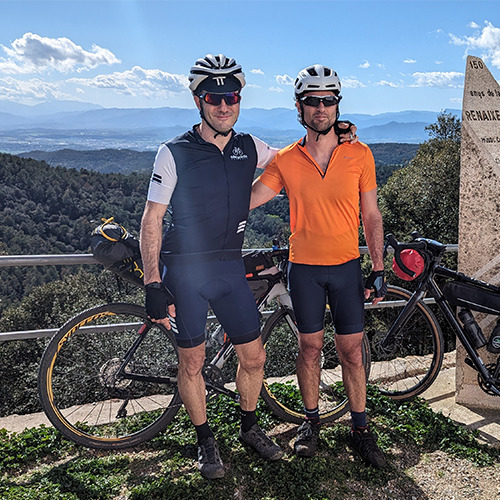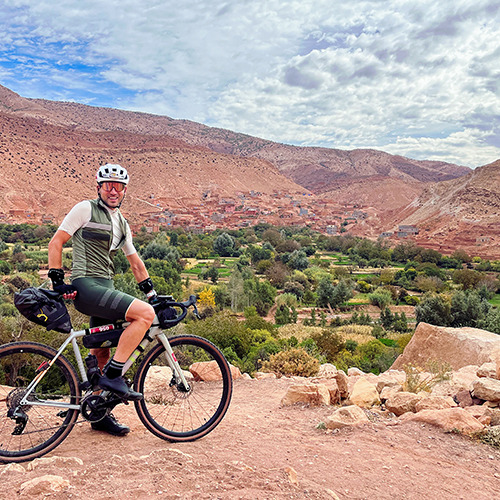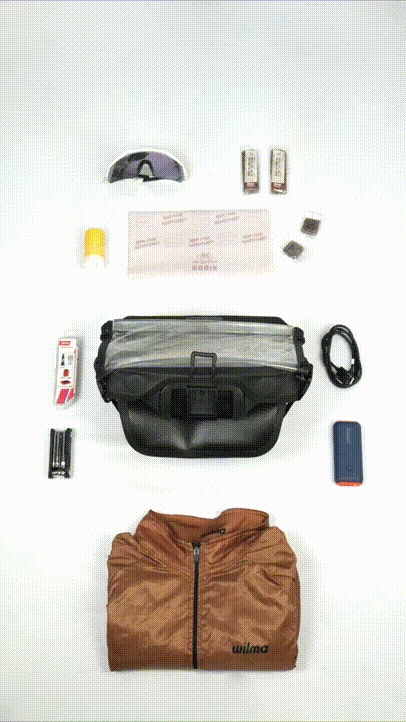Travel by Gravel Bike, The Complete Guide
17 July 2024
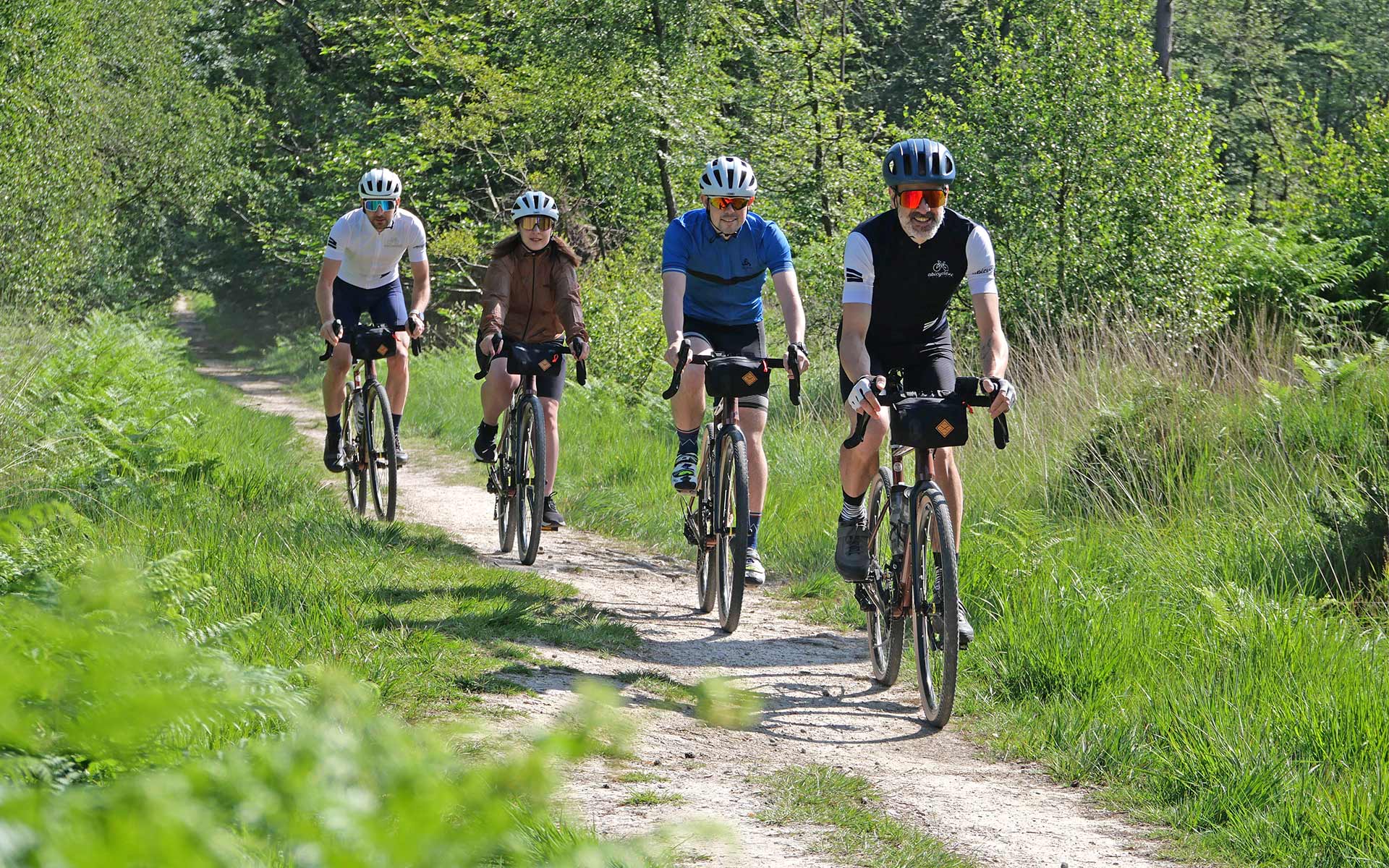
Some people enjoy flat asphalt roads, while others aspire to a rougher, more unpredictable adventure, wishing to defy the natural elements. This is where the gravel bike comes in!
Gravel biking is the art of combining the pleasure of cycling with a sporting challenge across a variety of landscapes. Whether on mountain trails, country roads or rustic dirt roads, gravel biking allows cyclists to get away from traditional roads and explore uncharted territory, all on a sporty, efficient and playful bike.
This comprehensive guide, enriched with practical tips and information, reveals everything that makes gravel a discipline both steeped in history and resolutely modern, with a bright future in the world of cycling.
Gravel, for cyclists with a thirst for adventure!
The term “gravel” refers to gravel roads, which are unpaved, gravel-covered roads. It’s a fast-growing cycling discipline, attracting more and more enthusiasts in search of adventure and freedom.
A bit of history…
Gravel embodies the essence of early bicycles, especially those designed for competition. At the end of the 19th century, main roads were still simple tracks, and it wasn’t until the end of the First World War that the first tarmac roads appeared. Bikes of the time were fitted with wide tires, offering both grip and comfort on these demanding surfaces. From the very first road cycling races in the early 20th century, the spirit of adventure and challenge was already omnipresent.
It was in the early 2000s, in the USA, that gravel riding as we know it today really took off. Cyclists were looking for an alternative to the increasingly busy and dangerous roads. They turned to dirt roads, exploring back roads and rediscovering forgotten landscapes. Events such as the Dirty Kanza (now renamed Unbound Gravel) were among the first gravel competitions, attracting hundreds of participants eager to push their limits on a variety of terrain.
Several factors have contributed to the growth of gravel in Europe. Firstly, Europe’s diverse landscapes provide an ideal playground, with winding country roads, picturesque forest paths and spectacular mountain trails. Secondly, the growing popularity of bikepacking – a self-sufficient form of cycle touring that allows you to travel light by bike – and of bike travel in search of authentic adventure, has greatly contributed to the popularity of gravel. More and more cyclists are looking to escape traffic and discover new horizons.
Today, gravel has established itself as an essential discipline for many cycling enthusiasts, attracting enthusiasts from all walks of life in search of stimulating challenges and breathtaking panoramas. All over Europe, gravel events and races are organized, offering participants the opportunity to test their skills and endurance over a variety of terrains and distances. Gravel is much more than just cycling: it’s a return to our roots, a journey through time and space, where every outing becomes a real adventure.
Gravel, a culture in its own right
Gravel culture is marked by a spirit of camaraderie and discovery. Unlike road cycling competitions, which are often characterized by strong competitiveness, gravel emphasizes inclusiveness and the sharing of experience. Gravel events have become a must for enthusiasts of this discipline. These events are not just races, but festivals celebrating the gravel spirit with exhibitions, workshops and community evenings. They also offer the opportunity to meet cyclists from all walks of life and share experiences and advice.
Another novel aspect of gravel culture is its influence on the bicycle industry. Many brands are developing bikes and accessories specifically designed for gravel, with features such as wider tires for better grip, sturdy frames to withstand rough terrain, and innovative luggage systems. Cyclists often adopt a minimalist lifestyle, packing the bare essentials for their adventures, adding a dimension of simplicity and back-to-basics to the practice.
Finally, gravel culture encourages a respectful approach to the environment. Cyclists are often sensitive to the preservation of the landscapes they cross, adopting sustainable practices such as “Leave No Trace”. This ecological awareness reinforces the idea that gravel is more than just a sport, it’s a way of life in harmony with nature.
Gravel, an incredibly versatile bike
The gravel bike embodies a revolution in the world of cycling, offering a versatility that appeals to two-wheeled enthusiasts across the globe. Designed to cope with an impressive variety of terrain, from asphalt roads to gravel paths and forest trails, the gravel bike has become the preferred choice for those seeking both adventure and performance.

Bike characteristics
Gravel bikes, specially designed to tackle a variety of surfaces and conditions, feature several unique characteristics. Inspired by road bikes, they nevertheless incorporate key differences that make them perfectly suited to varied terrain.
- Gravel bike frames can be made of aluminum, steel or carbon fiber, combining lightness and strength. Their geometry is optimized for greater stability and comfort on rough terrain, thanks to more open steering angles and extended chainstays.
- A gravel bike, with an average weight of 9.5 kg, is distinguished by its lightness, offering great practicality for a variety of situations. This featherweight not only ensures optimum manoeuvrability over varied terrain, but also makes it easier to carry the bike over natural obstacles such as rivers or steep paths.
- The tires are wider than those on conventional road bikes, generally measuring between 35 and 45 mm. This extra width provides better grip and shock absorption on uneven surfaces, for a smoother, safer ride.
- Disc brakes are another distinctive feature, offering superior stopping power and improved modulation, crucial for maintaining control over varied terrain.
- Gravel bike drive systems are versatile, with developments adapted for speed on flat, rolling sections, as well as small developments for steep climbs.
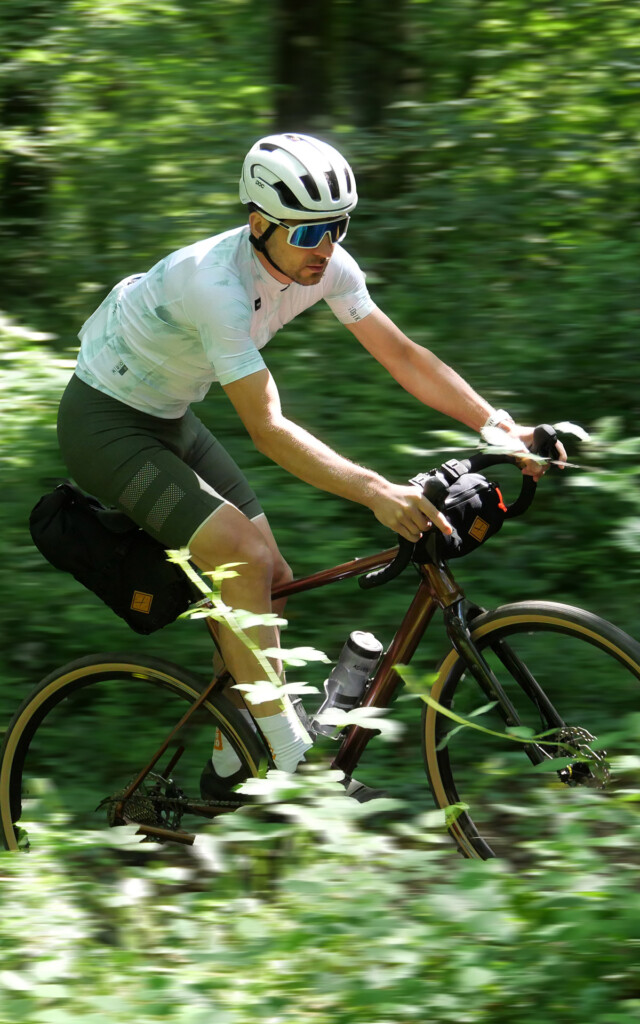
Different gravel practices
The gravel bike, considered a mix of road bike and mountain bike with a touch of cyclo-cross bike, allows you to adapt the configuration to your preferred riding style. Before choosing a bike, it’s important to define your riding style. Some gravel bikes are designed for speed, while others are intended for long outings. Gravel racing bikes have a geometry similar to that of road bikes and are minimalist, while bikepacking gravels offer a more adaptable configuration, thanks in particular to bolts that allow a wide variety of panniers to be fitted.
- Performance gravel: performance gravel is oriented towards speed and efficiency on a variety of surfaces, often mixing asphalt roads with gravel paths and light technical sections.
For high-performance gravel riding, bikes are characterized by a geometry close to that of road bikes, favoring an aerodynamic posture and maximum pedaling efficiency similar to traditional road bikes. The frame has to be both light and rigid, allowing greater responsiveness during acceleration and ensuring optimum transmission of power. The tires used are thinner and more streamlined, offering low rolling resistance on smooth surfaces while maintaining sufficient grip on gravel roads. In addition, the option of installing automatic pedals is available to enhance the gravel bike’s overall performance.
- Adventure gravel: this gravel practice focuses on exploration and endurance over long distances, often over several days, with an emphasis on comfort and the ability to carry everything you need for self-sufficiency.
For gravel adventure or touring, it’s essential to look for a bike with comfortable geometry that offers a less aggressive riding position, ideal for reducing fatigue over long distances. The frame should be sturdy, with loading options such as attachment points for panniers, to easily carry all the gear needed for camping, food and other equipment. Finally, wider tires with good grip are essential to ensure better traction on rough gravel paths and varied surfaces, guaranteeing greater stability and safety during gravel adventures.
Our gravel bikes for rent
During your next stay with Abicyclette Voyages, you can rent Vadrouille gravel bikes from Adris. These bikes are specially chosen for their local manufacture in Brittany, a region at the heart of our business. Founded by cycling enthusiasts Adrien and Romain, Adris designs and assembles all its bikes in this region. Inspired by their racing experience, they have meticulously integrated their expertise into every detail of this Vadrouille bike. The result? A perfect combination of top-level performance, optimum comfort and remarkable design.
The Vadrouille stands out for its exceptional versatility: its lightness, maneuverability and elegance make it an ideal companion for all your adventures. Equipped with an aluminum frame and carbon fork, every component of the Vadrouille is designed for perfect integration and maximum durability. With the Shimano GRX400 groupset, this Gravel bike exceeds all expectations in terms of robustness and performance, suitable for all terrains, whether demanding or unexplored.
© Abicyclette Voyages © Abicyclette Voyages © Abicyclette Voyages
Which equipment to choose?
When it comes to gravel riding, it’s essential to choose equipment that’s comfortable, versatile and suited to the variable conditions encountered on unpaved roads and trails. Here are some recommendations for different types of equipment:
The outfit
Choose clothing that is breathable, moisture-wicking and quick-drying. A lightweight base layer of breathable material helps regulate body temperature during activity. Jerseys with rear pockets are practical for carrying small items such as energy bars or a telephone. For bottoms, cycling shorts ensure optimum comfort during your ride. Don’t forget to keep a windbreaker handy, easy to slip into your front pannier. In gravel, it’s not uncommon to have to dismount to overcome obstacles, cross technical sections or carry your bike. For this reason, it’s essential to choose shoes that combine walking comfort and rigidity, to ensure good power transmission while remaining practical on foot.
The bags
On your gravel bike, you’ll find several anchor points for attaching panniers. The main quality sought in bikepacking panniers is their light weight, enabling minimal loading. The equipment used generally includes the frame bag, handlebar bag and saddle bag for gravel adventures. There are a number of bikepacking brands making handcrafted panniers in France, here are 3 examples we like at Abicyclette Voyages: Le rouquin qui roule (made in Rostrenen, central Brittany), Akao Designs (made in Saint-Malo, Brittany), Vélocidade (made in Ariège). It’s essential not to be overwhelmed by excessive weight, and to check the pannier fastening system carefully so that it fits perfectly on your bike, ensuring optimum stability whether you’re riding on smooth roads or uneven terrain.
The tools
Get yourself a multi-tool. This type of tool is designed to cope with every possible situation. Whether you’re looking for a chain adjuster or a tire iron, this essential gravel accessory will give you peace of mind. You’ll also need to pack a repair kit, including plastic tire levers and patches. A spare inner tube is also essential, especially when you’re riding over rough, unmaintained terrain, where punctures can occur quickly, even if your gravel bike is fitted with tubeless tires. Last but not least, the pump remains the essential repair tool for all cyclists.
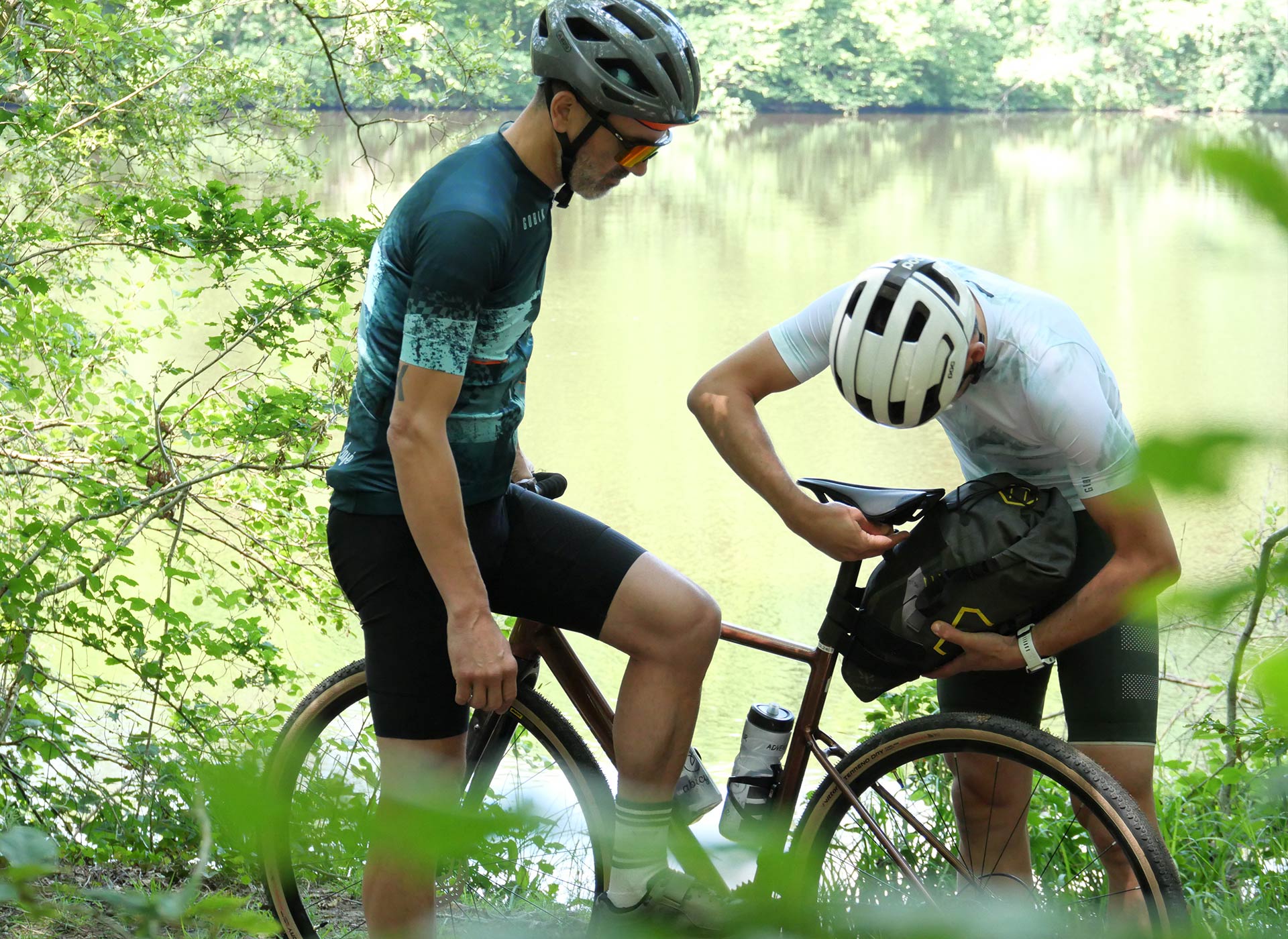
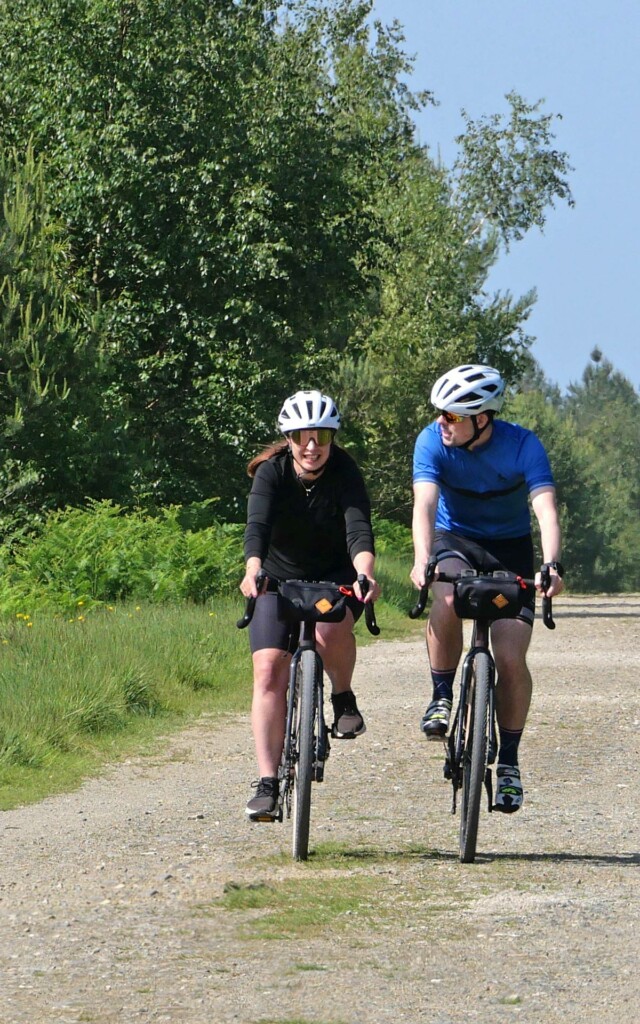
Our tips for gravel riding
- To begin with, it’s best to choose simple routes on easy, low-tech paths, such as canalsides, parks and greenways. Then, when you feel more comfortable, you can venture onto more technical routes.
- Start with short outings. Short rides are ideal for acclimatizing and perfecting your equipment. Don’t exceed 60 km, and choose easy destinations for beginners.
- When planning your trip, allow time for the unexpected. Riding in the wilderness can lead to surprising and beautiful places. An opportunity to get off the bike and explore further.
- To get the most out of gravel tours, learning the basics of bike repair, such as changing an inner tube, adjusting brakes and setting derailleurs, is invaluable. These skills are invaluable in the event of a problem on the road, enabling you to continue your ride without too much hassle.
- Take the time to apply your handlebar tape properly. It improves grip in wet weather (rain or perspiration) and adds comfort by absorbing vibrations. The thicker the tape, the more comfortable it is.
- When it comes to bikepacking, the less accessible panniers will hold your evening essentials, those not needed during the day. This generally includes sleeping gear, a change of clothes, toiletries and any other equipment not needed before setting up camp.
- More easily accessible panniers, such as the one attached to the handlebars, are reserved for items needed during the trip. These often include food, water, repair tools, a first-aid kit and rain gear. These panniers make it possible to deal quickly with changing weather conditions or urgent needs without having to rummage through all the equipment.
- Fun for all! In addition to the physical challenges and wilderness outings, gravel riding is also synonymous with simple, authentic pleasures that enrich the cycling experience. Among these pleasures is the traditional coffee break, a privileged moment when cyclists gather around a steaming cup of coffee to regain their strength, swap stories and share tips on upcoming routes.
Ready for your first gravel adventure?
Now that you know a little more, you’re ready to embark on a gravel bike adventure, and you’ve made the right choice! Here are a few more tips to help you prepare for your first outing, organize your days and plan a gravel bike trip:
First gravel bike outings
- Choice of route: opt for easy routes, without too many differences in altitude. Use apps like Komoot or Strava to find routes suitable for beginners. Make sure the terrain matches your skill level and fitness level. Country roads, greenways and cycle paths along canals are ideal playgrounds for getting started with gravel.
- Essential equipment: wear a helmet, gloves and weather-appropriate clothing. Don’t forget a repair kit, pump and spare inner tubes.
- Food and hydration: carry enough water and energy snacks to maintain your energy levels (600ml of water and 60g of carbohydrates per hour of practice). Isotonic drinks, energy bars, dried fruit and nuts are good options.
- Riding technique: adapt your technique to the terrain. When riding downhill, place your body more on the back of the bike, standing with arms slightly bent and feet parallel for greater stability. On uphill, stay seated, rather on the front of your saddle (beak) to maximize grip.
Organization of your gravel day
- Planning the day: define your itinerary in advance and share it with someone for safety reasons. Plan regular breaks to rest and rehydrate.
- Equipment to take with you: in addition to the basic equipment, consider taking a GPS or smartphone with an external battery. A first-aid kit can also be useful in case of injury.
- Weather management: check the weather forecast before you set off. Take along a windbreaker or waterproof jacket if showers are forecast. Sunglasses and sunscreen are also important on sunny days.
- Safety: respect the rules of the road and be alert to other road users, especially in areas shared with motorized vehicles. Use front and rear lights to be visible, even in broad daylight.
Organization during your gravel bike trip
- Route planning: plan your trip according to points of interest, available accommodation and distances achievable on a daily basis.
- Luggage and equipment: invest in frame, handlebar and saddle bags to distribute weight evenly. Pack versatile, lightweight, quick-drying clothing.
- Food on the road: Plan your meals according to the availability of refreshments along your route. Meals prepared for touring cyclists can be a good solution for stages where shops are scarce.
- Managing fatigue: listen to your body and adapt your pace accordingly. Plan rest days or shorter stages to avoid overexertion. Take the time to stretch well after each day’s cycling to prevent soreness.
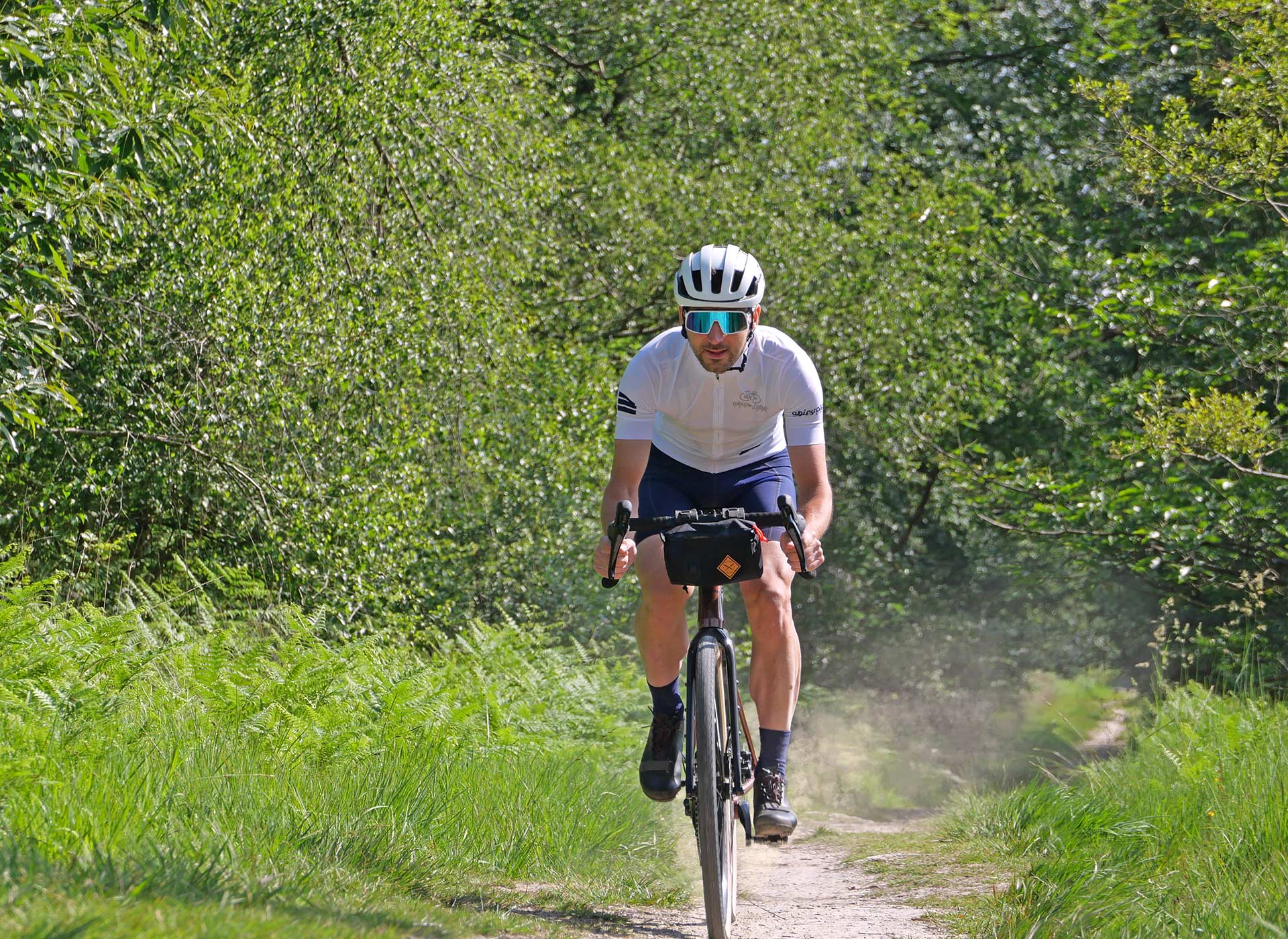
Choosing your gravel destination
Choosing a gravel destination isn’t a matter of chance. In fact, a good gravel destination is often linked to a certain type of territory, offering an ideal playground for this cycling discipline.
Mid-range mountains: an ideal playground
The mid-mountain region is particularly well-suited to gravel riding. These regions are characterized by a varied but accessible terrain, with few asphalt roads and many groomed trails. The trails are often quite wide and relatively well maintained, enabling safe riding without the need for a mountain bike. In France, several regions stand out as gravel-friendly destinations:
- Massif Central: this region, with its dormant volcanoes and verdant landscapes, offers a dense network of gravel roads, perfect for gravel riding.
- Ardèche: famous for its gorges and plateaux, the Ardèche offers picturesque and varied itineraries through forests and vineyards.
- Lozère: with its vast natural expanses and gentle mountains, Lozère is a paradise for gravel enthusiasts.
- Provence: beyond its famous lavender fields, Provence offers gravel trails through its hills and picturesque villages, in a sunny climate.
Mediterranean countries: gravel paradise
The Mediterranean countries are also prime gravel destinations, mainly thanks to their favorable weather. Summers are hot and dry, and winters mild, with little precipitation. Trails are often dry and stony, ideal for gravel riding. Must-see destinations include:
- Spain: with its vast natural spaces and numerous gravel trails, Spain offers a variety of routes, from the Mediterranean coast to the inland mountains.
- Portugal: between ocean and mountains, Portugal offers gravel routes through its diverse landscapes and authentic villages.
- Italy: whether in Tuscany, with its famous “strade bianche”, or in the Dolomites, Italy is a dream destination for gravel enthusiasts.
Kirghizistan: the ultimate adventure
For those seeking an even more remote and exotic adventure, Kyrgyzstan is a trending destination for gravel riding. This largely mountainous and geographically isolated country is developing its tourist appeal. It is appreciated for its gravel roads, ancient pastoral culture and spectacular scenery. Kyrgyzstan offers a unique experience, combining exploration and a change of scenery, for cyclists eager to discover new horizons.
To find out more about gravel riding…
We hope that this guide to gravel riding has given you the opportunity to discover more about this exciting activity, and that it has inspired you to get (back) into it. To deepen your knowledge of the subject, we’ve put together a selection of resources and stories to immerse you in the world of gravel:

